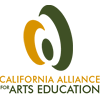Introduction
The purpose of The Insider’s Guide to Arts Education Planning is to provide a hands-on, how-to planning process for schools, districts and counties, which enables them to assess, envision, and implement quality visual and performing arts programs for their students. Field-tested by experienced Arts Education Planning Coaches and Community Arts Teams, the guide offers best practices, innovative ideas, templates and strategies to navigate the sometimes challenging terrain of arts education planning. The California Alliance for Arts Education is pleased to offer this guide as a tool and catalyst for strategic thinking and district wide planning throughout California.
The guide grows out of the Community Arts Education Project (CAEP), a 2001 jointly sponsored initiative of the California Alliance for Arts Education and the California State PTA. The project is aptly named and intentionally inclusive in that it fully engages members from both the community and the district in building an arts education vision for all students.
The original project was conceived as both a guidebook and a hands-on technical assistance process that enables districts to assess current arts learning programs and funding allocations, identify gaps in delivery, and create strategic plans that will ensure equitable access for all students in each of the four arts disciplines.
The Alliance has developed and refined the process through practice. Working in collaboration with Arts for All, a Los Angeles County strategic initiative to restore dance, music, theatre, and the visual arts in all districts throughout the county, the Alliance has provided Arts Education Planning Coaches to more than 30 Arts for All districts since 2003. Over a 12- to 18-month period, district and community members in each district participated in a strategic planning process, culminating in the presentation – and adoption – of a district arts education policy and a long-range budgeted plan.
The purpose of system-wide planning in arts education is to:
- Improve access to arts education for all California students through a planning process that engages leaders representing the district administration, school board, PTA, and the community.
- Identify, cultivate, and empower arts education leadership among the diverse spectrum of stakeholders and sectors charged with implementing quality arts education in the schools.
- Assist parents in becoming advocates in their children’s schools for stronger arts education programs.
- Build partnerships and collaborations with community resources (people, facilities and funding available for arts education programs.)
Projected Outcomes:
- The policies, action plans, and budget recommendations created from this process provide a long-range plan for implementation of a sequential, standards-based curriculum in the arts.
- The project raises community awareness and develops new relationships between the district and community members.
- The project and subsequent long-range plans provide models for other school districts, both locally and nationally.
The planning process that is described in the guide, based on facilitation methods from the Institute of Cultural Affairs, guarantees full participation from various stakeholders and is predicated on values that are increasingly being modeled in our world — even in the new administration at the White House. The idea is that every member of the team has an important piece of the larger puzzle, and each individual offers a valuable perspective that will contribute to the greater good. All views or sides can be heard and considered without labeling any person as right or wrong. The methods allow a group to find common ground they can stand together on and move beyond disagreements and bridge differences. This approach empowers a group to action, and participants leave knowing exactly what their roles are in actualizing the plan.
A Word on Terminology
Definitions of terms used throughout this guide.
- Visual and performing arts (sometimes shortened to arts education, arts, or VAPA) refers to the K-12 course of study adopted by the California State Board of Education, including the four disciplines of dance, music, theatre, and visual arts.
- Standards-based refers to arts education programs, curricula, instructional materials, instruction, and assessments that are not merely aligned with the state standards, but rather are directly and intentionally founded on, derived from, and fully reflective of the scope and sequence presented within the Visual and Performing Arts Content Standards for California Public Schools (2001) and the Visual and Performing Arts Framework for California Public Schools (2004). Both of these documents can be downloaded at: http://www.cde.ca.gov/ci/







